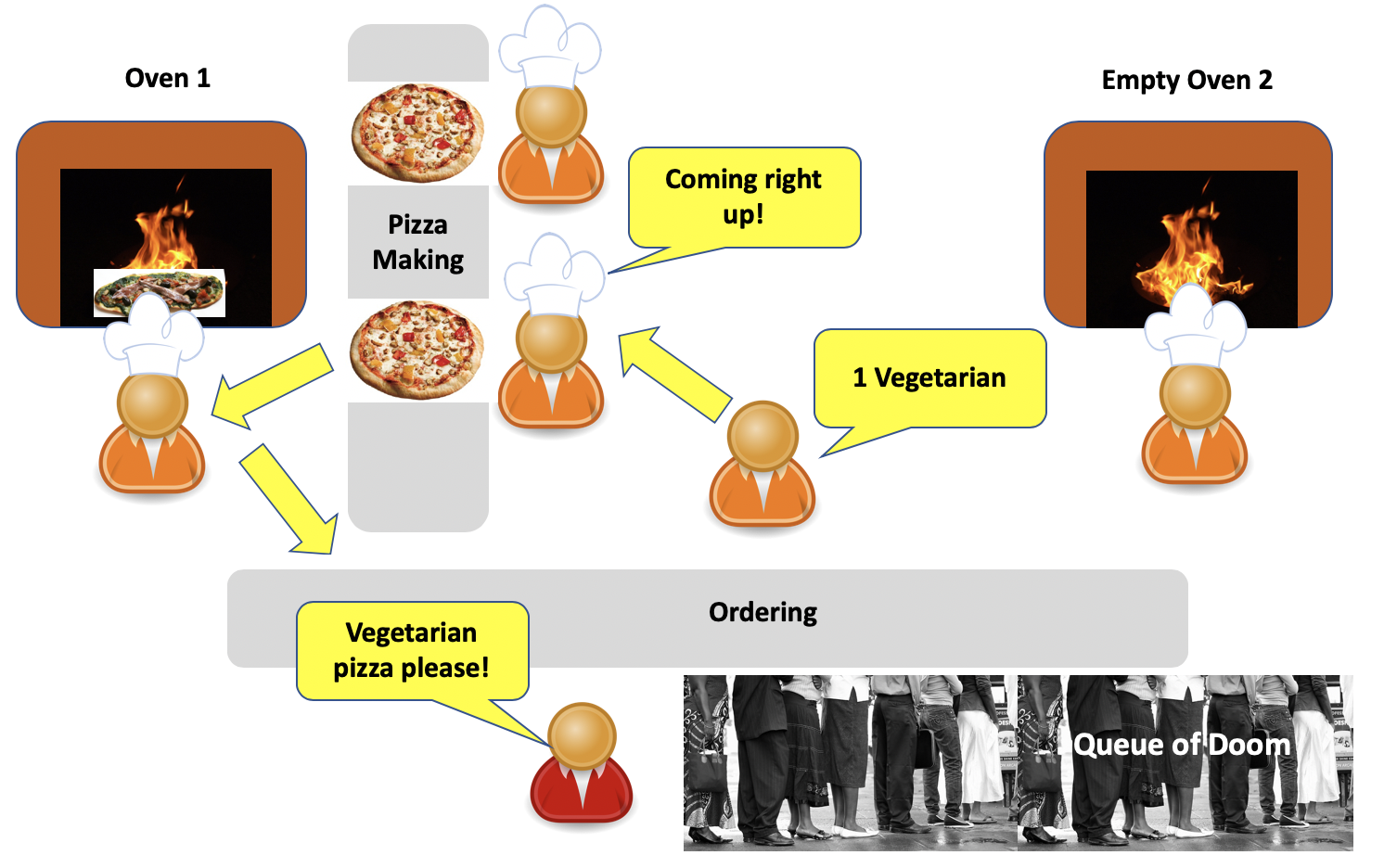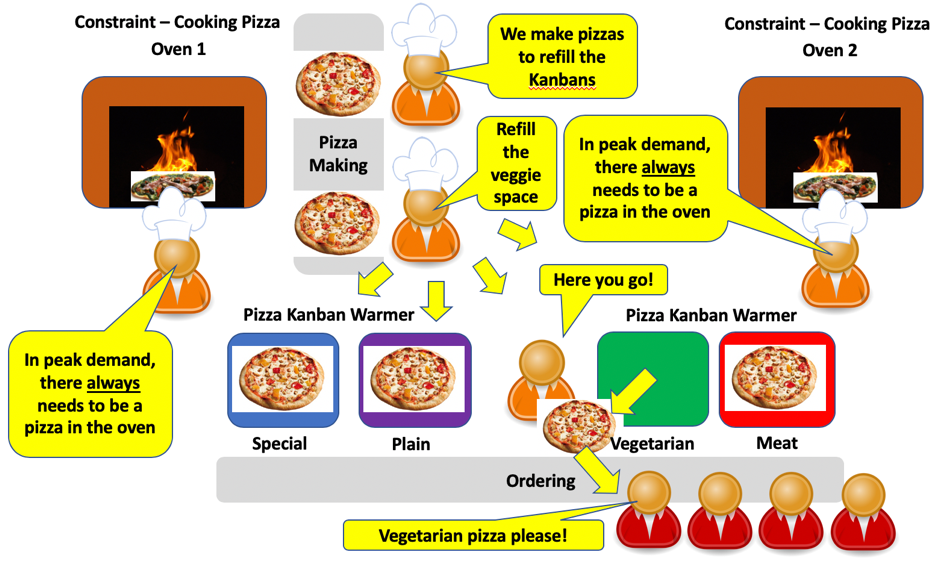Pizza Productivity
21 July 2019
In my lectures I often joke that once you start seeing the world from a lean perspective, things that you used to enjoy can start to become quite frustrating because you can see the room for improvement everywhere. I recently had a brilliant day at a mini festival in Cardiff with my friends but the queue for a pizza nearly had me jumping over the counter and making the staff participate in one of my workshops. The queue was actually quite fun because me and my friends were catching up, but when I got to the front I could clearly see that there were major problems in their pizza production line and when I got back to my other friends, I was chastised for worrying them because I had been OVER AN HOUR.
In terms of increasing productivity and minimising the amount of ingredients needed (and therefore waste) the pizza company were on point because they only a had a few pizza choices to pick from, a cheese, a vegetarian and a meat and one other (I had sampled a few wines that day, forgive me) but I posit that they didn’t maximise the benefits that come from the simplicity of their ingredients and menu.
I only witnessed what was going on behind the counter for the few minutes when I was at the front of the queue and *disclaimer* I am not an expert in cooking pizza and have no idea whether you need to ‘rest’ pizza ovens or how much value customers put in a ‘made to order’ pizza, how much they actually value that one hour wait to get that pizza (as Rory Sutherland explains in his book Alchemy, customers are weird) but in that moment, after one hour of waiting and missing the start of the headline act, I really felt that changes could be made to get people their pizza quicker, and yes, to make that company more money.
The first thing I noticed was that they had two pizza ovens but often one of the pizza ovens was empty and that they were often only cooking one pizza in an oven at a time. Maybe this is how pizza ovens are meant to work but given the queue, I would have attempted to shove a few in and hope for the best! Eli Goldratt in his book ‘The Goal’ outlined his ‘Theory of Constraints’ and really elevated the importance of understanding where bottlenecks exist within your processes as they dictate your whole pace of production. In simple terms, a chain is only as strong as its weakest link, so in order to maximise the throughput of any process, you must maximise the ability of the constraint to do its job. Cooking the pizza, whilst relatively quick because of the ovens, takes the most time in the process. Applying this concept to my pizza purchasing experience, the pizza ovens should not have been empty, ever.
The second thing was that they were ‘making to order’ with what appeared to be a ‘push’ manufacturing process i.e. “I want a vegetarian pizza, ok, we will make you one – *roll out dough, add tomato sauce, toppings and cook* – and voila! I have tried to describe this in the diagram below (I was at a festival and wasn’t running a mapping workshop so this may have errors).
In times of peak demand they needed to move to more of a pull process in order to get people their food. I desperately (and tragically) wanted to set up just a simple Kanban square system, to encourage them to move to a replenishment pull system. Something like the below.
A Kanban is just a signal within a process to say ‘I need one’. If the customer buys a vegetarian pizza, the vegetarian pizza Kanban space is now empty. This is a visual signal to tell the cooks that they need to make a vegetarian pizza to replace the one that has just been bought. It’s as simple as that. The downside of a Kanban food system is that you if someone hasn’t bought one type of pizza in a while, it will just sit there going cold, that’s why I’d suggest that the Kanban spaces were warming plates. There is also the potential that you’ll have to throw out pizzas that haven’t been bought after a short while, which is a waste, but I think that you could probably shift these ‘cold’ pizzas cheaply and are a small price to pay for a much greater throughflow of custom.
You’d need to load up the system with pizza, confident that the demand was such that you’d be able to sell many pizzas a minute but once the system had been embedded, you could better tweak the Kanban to reflect demand, having more of the most popular pizzas ready to purchase and maybe keeping the least popular pizza to a ‘make to order’ process to minimise waste.
There needed to be a decoupling from customer demand and production supply in order to maximise the 1) human resource they had available to make and cook pizzas and the 2) physical resource that they had to cook the pizzas – the two pizza ovens.
As we waited in the queue, one of the members of the team came along in the queue and asked us how many pizzas we were going to order because they wanted to know if they had enough ingredients left to service the queue. Again, this feels like a common ‘posh food truck’ experience at festivals etc., they nearly always run out, and to a lean thinker this makes no sense. Indeed, most of the other food trucks on site had run out of food already and this truck was the last one that was operational, so you could say that they had best bet on the amount of ingredients they’d need. To return to my earlier thought, perhaps everyone knowing that these trucks nearly always sell out is, again, part of the appeal? Anyway.. back to bucks and I wonder though how many people couldn’t face that queue, and how much they could have sold if they had been more efficient? Could they have sold double what they had brought with them if they were quicker in making them? I’d suggest that the answer is ‘probably’.
So I return to my initial point, I had a great time at the festival with my friends and once I did finally get a pizza, it was delicious. However, rather than look over the instagrams, rewatch the videos, chat to my friends about the funny things that happened, I’ve written a blog about how to make pizzas quicker. Lean. Go figure.
Comments
1 comment
Comments are closed.
- Lifetime Loyalty and Taylor Swift
- Looking at Things Differently
- Networking Noodles
- Addicted to Truth
- Designs on Service Design
- The Multiple Joys of Universal Design
- Hungry Cultures
- Event Lean
- The Traffic Analogy
- Moving on Up
- Rosé Cava Revolution?
- Powerpoint Sneaky Lean
- Writing about Writing
- ChatGPT Response: Exploring the Art of Expression: Unveiling the Magic of Writing in the Style of Sarah Lethbridge
- Help to Grow Coldplay Style
- Caring IS Everything!
- Institutional Flapping
- “Just Do the Next Right Thing”
- Trust Thermoclines
- Organisational Tempo
- The Inaugural Lethbridge Customer Service Awards
- Vaccine Lean – The Dawn of the Water Spider
- The Queen and Lean
- Decisions, Decisions, Decisions
- Peaceful Protest
- Tesla Tales
- Back to Reality!
- Carrots, Sticks and Buckets of Time Tricks
- The Great Pandemic Pause
- Organisational Therapy
- Late Night Wordleing
- Vaccine Lean
- Chief Letters of Complaint Officer
- AMBAZING Accreditation!
- My Big Lean Head
- [Let us] Help [you] to Grow: Management
- The Love Island Blog
- More Haste, Less Speed
- The Power of Persistence
- Brain Training
- July 2024 (1)
- June 2024 (1)
- May 2024 (1)
- March 2024 (1)
- February 2024 (2)
- December 2023 (2)
- October 2023 (2)
- September 2023 (1)
- July 2023 (3)
- June 2023 (1)
- May 2023 (1)
- April 2023 (1)
- March 2023 (1)
- February 2023 (1)
- January 2023 (1)
- November 2022 (1)
- October 2022 (2)
- August 2022 (2)
- July 2022 (1)
- May 2022 (2)
- April 2022 (1)
- February 2022 (1)
- January 2022 (1)
- December 2021 (2)
- November 2021 (1)
- October 2021 (1)
- September 2021 (1)
- August 2021 (1)
- July 2021 (1)
- May 2021 (2)
- April 2021 (1)
- March 2021 (1)
- January 2021 (1)
- December 2020 (1)
- October 2020 (3)
- August 2020 (1)
- June 2020 (2)
- April 2020 (1)
- March 2020 (1)
- February 2020 (1)
- December 2019 (2)
- October 2019 (1)
- September 2019 (1)
- August 2019 (1)
- July 2019 (1)
- June 2019 (1)
- February 2019 (3)
- October 2018 (1)
- September 2018 (1)
- March 2018 (10)
- April 2016 (1)
- January 2015 (3)
- July 2014 (9)
- September 2013 (1)




Awesome blog! I like it a lot! Thanks and keep up the great work!